Routes 9/10/A (incl: 4/5/9P variants):

DAF re-engined CIE Metal Sections bodied Leyland Atlantean PDR1A/1, DF566, is seen operating a Route 10 service to Belfield in April 1991. D566 was delivered to Phibsborough Depot in April 1974. Due to mechanical reliability issues that CIE had with the Leyland Engines, they began fitting Atlanteans with DAF DK1160 (11.6 litre) engines derived from the original Leyland 680. D566 was one such bus and was therefore designated DF566. The bus would give 18 years of service to Phibsborough Depot before bowing out in October 1991 with the delivery of RH117-RH120.
This week saw the announcement we all knew was coming. Dublin Bus are to withdraw Route 10 on the 30th October 2010 (this coming Saturday). DublinbusStuff provides a detailed account of the Route's history, along with that of its sister Route 9. The variant of the 4 and 5 that were used in conjunction with the above routes are also detailed. Historical photographs from renowned photographers Darren Hall and Patrick Losty give a graphical account of the bus operational history of the 10 over the last 20 years.
The 10 is one of the most historic of all Dublin Bus routes. Originally a secondary service to the 9, the 10 would eventually fully replace it. The 20 year existence of the 4 from the mid 60's to 80s was as a "short" 10, adding much needed extra capacity to a well used service. Though it's not the first time that Route 10 has been cancelled, the 30th October 2010 may herald the final knell for this much loved route. The number may well appear again in the future, a route renumbering process would be logical after the Network Review, however it's unlikely that the Phoenix Park service will ever be numbered 10 again. "Take the 10 to the Zoo" will be a phrase that will echo through the ages, but sadly it's no longer applicable.The Donnybrook section of the route was the first to receive a horse-drawn tramway in early March 1873. It was operated by the Dublin Tramways Company (DTC). The routing was as follows:
O'Connell Street (Sackville Street), Westmoreland Street, College Green, Grafton Street, Nassau Street, Leinster Street South, Clare Street, Merrion Square North, Merrion Square East, Lower Fitzwilliam Street, Baggot Street, Waterloo Road, Morehampton Road, Donnybrook Road (terminating at Donnybrook Church, opposite the tramway sheds were Donnybrook2 bus garage now stands).
The Pembroke township like the vast majority of the tramway network represented an affluent source of passengers. However one should note that Donnybrook was not always a centre of affluence. Long before the term "Dublin 4" an annual fair was held in Donnybrook. The fair began in 1204, a place of congregation for fiddlers and dancers. It typically ran for 15 days in late August/early September.
This Donnybrook fair was notorious for its drunkenness and violence. Whiskey fuelled fights were common place, the shillelagh a common weapon. Such was the level of violence it became notorious throughout the British Empire. For this reason, the very term Donnybrook in the English language means a brawl or fracas. The fair was finally banned in the late 1860s a few years before the arrival of the tram service. Fittingly Donnybrook would find itself host to a European title fight. The French European Featherweight Champion, Ray Famechon, took on Billy Kelly from Derry in May 1955 in the Donnybrook 2 bus garage designed by Michael Scott. Billy Kelly lost, though somewhat undeservedly, and the referee was attacked on leaving the ring.
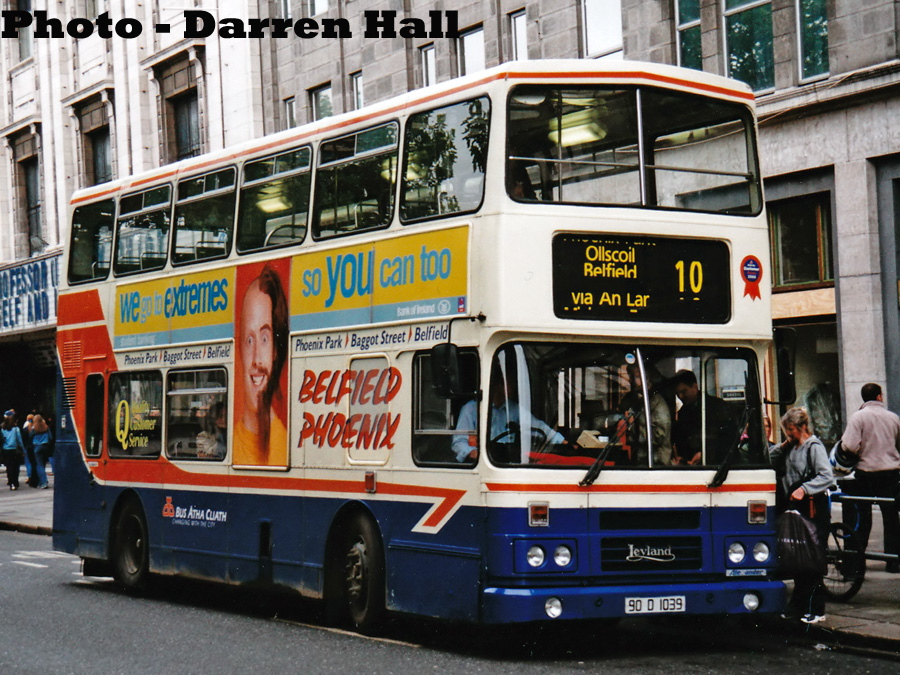
Alexander RH-bodied Leyland Olympian, RH39, is seen operating a Route 10 service to Belfield on the 7th October 2000. This bus had been delivered to Phibsborough Depot exactly 10 years previously in White Wedding Bus livery, the first one to be delivered as such, though RH3 and KD366 had been repainted as such. The bus is seen here in the Dublin Bus Core livery of Blue and Cream used in the late 90s early 00s. The bus has decals for the Quality Bus Route 10 between Belfield and Phoenix which were applied in the first half of 1999. Intermediate Points of the Route are shown on the side. These buses however were never strictly allocated to the 10, hence the decals had little effect. RH39 was withdrawn in the summer of 2002, and sold on to Ensignbus for futher use elsewhere.
Interestingly when the Donnybrook line was opened the service was alternatively (every 2nd tram) via Nassau Street or Westland Row. The Sandymount Line, what was to become tram route 4, then bus route 52, had started a few months previously to the Donnybrook line. This had initially used Westland Row at all times, however when the Donnybrook line opened the DTC decided to run both services alternatively via Westland Row or Nassau Street to Nelson's Pillar. This lasted a few weeks, ending on the 20th March 1873, at the behest of many complaints from passengers. Trams to Sandymount ran via Westland Row, while those to Donnybrook ran via Nassau Street.
Though the idea of alternating tram routes like this opened up more connections for passengers of both routes, it also doubled the waiting times on the individual sections. For the waiting passenger it was best to have a core defined route, something that is at the heart of the current network review. The vehicles may have changed considerably but the principles of operating a transport service have seemingly changed little. 30 years later the principle of alternating the Donnybrook trams would return, though St. Stephen's Green and Lower Baggot Street would be the alternate.
The horse drawn tram service to the Phoenix Park from Nelson's Pillar began on the 10th December 1876, operated by the North Dublin Street Tramways (NDST). The routing was as follows:
Nelson's Pillar, O'Connell Street (Sackville Street), Parnell Square East (Rutland Square East), North Frederick Street, Blessington Street, Berkeley Street, Berkeley Road, North Circular Road (terminating at the Phoenix Park Gate).
The route served a number of places of interest such as the Mater Hospital, Grangegorman Hospital, Phibsborough, the Cattle Market at Prussia Street, McKee (Marlborough) Barracks and of course the Phoenix Park and Dublin Zoo, which had opened more than 40 years previously, the third oldest zoo in the world. The Phoenix Park was a common destination for day trippers from the city. Opened to the public in 1745 by Lord Chesterfield, whom the main road through the park is named after, the park encompasses 1,750 acres.
The depot for these trams was built in Phibsborough, though was always called "Cabra". It adjoined Dalymount Park, hence the use of the term Tramway end for one of their stands, and would become the biggest tram depot of the Dublin Tram system.
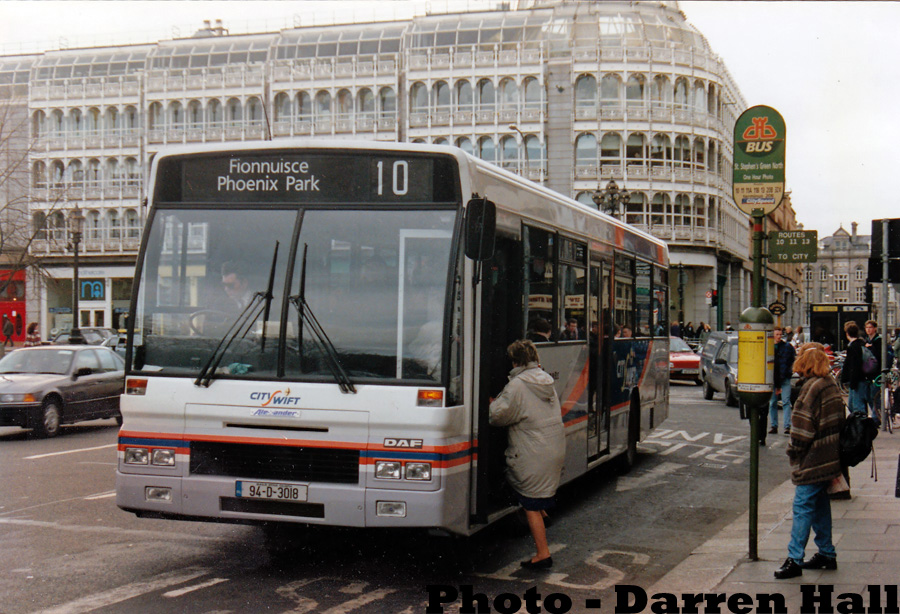
Alexander Setanta-bodied DAF SB220, AD18, is seen operating a Route 10 departure to the Phoenix Park on St. Stephen's Green North on the 11th March 1994. The flow of traffic around the park is clockwise in this shot, the current traffic arrangement being a recent thing introduced to accommodate the LUAS line. AD18 had a yo-yo allocation during its time with Dublin Bus. It was delivered to Phibsborough in early 1994, before transferring to Donnybrook in the summer, being transferred to operate Route 3. With the arrival of the AD40s to Donnybrook later in 1994, AD18 transferred back to Phibsborough, along with AD22/AD23 to cover for the P-class returning to the factory for attention. While in Phibsborough the bus was one of the AD-class to obtain two-tone green livery, shortly before the fleetwide introduction of the Blue/Cream Core livery. With the introduction of the ICON Shuttle in the Autumn of 1999 which was allocated two AD-class buses, AD18 returned to Donnybrook. It was painted into the Core livery on arrival in Donnybrook. It was again transferred back to Phibsborough in the Summer of 2003. It lasted less than a year there, being withdrawn in the late Spring with the transfer of AD44-50 from Donnybrook to Phibsborough. It was then acquired by Bus Eireann for schools work but remained unallocated for a number of months, before finally beginning schools work late in the year. It was finally withdrawn in May of this year (2010).
The Dublin Central Tramways Company merged with the North Dublin Street Tramways Company and the larger Dublin Tramways company to form the Dublin United Tramways Company (DUTC) in 1880. This enabled the Phoenix Park service to be extended down O'Connell Street and Westmoreland Street to a new terminus at College Green.
The horse tram served Dublin well from its inception however the high costs of maintaining such a system, especially with regard to the stabling of the horses, and the number required to operate a day's service, lead the DUTC and to look at alternative forms of traction. The solution came in the form of electricity, though it's introduction was no means easy. Lobby groups involved in the supply and upkeep of horses were strongly against the proposal, while civic authorities were concerned with the overhead wires and the general appearance of the city streets.
The Phoenix Park service was the first of the two lines to go electric on the 22nd November 1898, operating to Nelson's Pillar. On the 23rd January 1899, the Donnybrook line went electric and was joined with the Phoenix Park service, cars running from Phoenix Park straight through to Donnybrook. The term car was long used in Dublin in reference to a tram. In fact it is still used in Dublin Bus to this day, with drivers referring to buses as the 1st car etc... Both depots at Cabra and Donnybrook used by the radial services were used to supply trams for the cross-city services.
This date is really important from a Dublin public transport perspective as it was the start date of the first cross city tram service. Up to this point all services were radial from the city centre, save for the cross tram (Route 18) which did not serve the inner city. The Phoenix Park – Donnybrook service heralded a new idea on public transport provision, something that would lead to many cross city services in the years that followed.
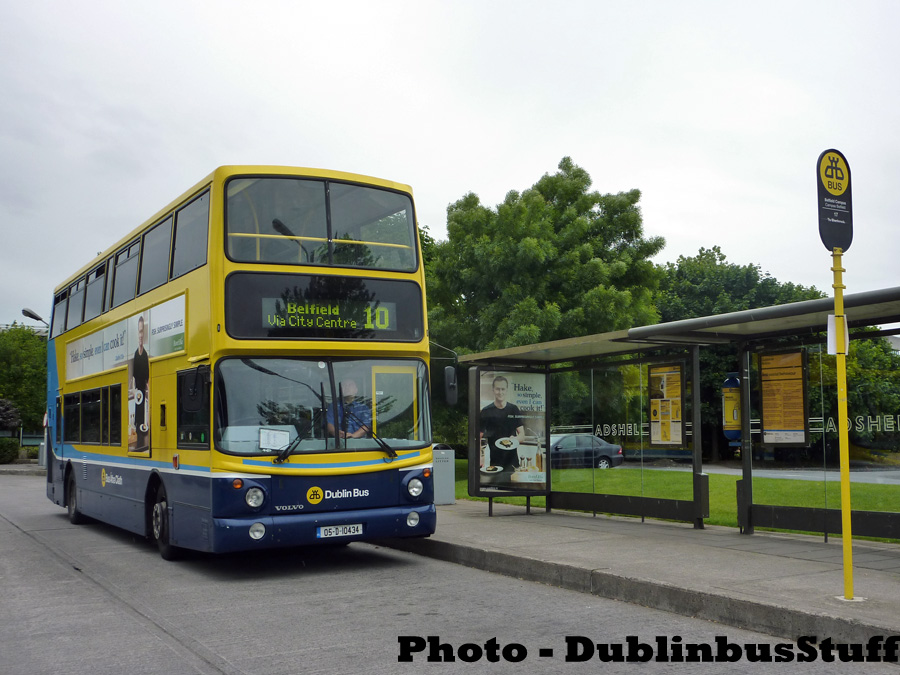
Alexander ALX400-bodied Volvo B7TL, AV434, is seen at its Belfield Terminus awaiting its time on the 7th June 2010. AV434 was delivered to Phibsborough in the Autumn of 2005 in the batch AV430-AV446. Hake was the fish of the day as Bord Bia advertisements meet, the offside of the bus and the advert on the shelter indicating that even a man (is he famous??) could cook hake.
The conversion of the Donnybrook tram to electrics is also the basis for one of the most well known of tram stories. The Donnybrook tram's conversion to electric traction occurred during the years of The Boer War. Good horses were in short supply, and many of the ex-DUTC horses were sold onto the British mainland. At North Wall one faithful day, an old trace horse resisted every form of persuasion to cross the ship's gangway. A passerby, on seeing the horse's refusal, blew a whistle and shouted: "Now then Donnybrook." The horse instantly moved along. This story, often told, shows the obedient nature of these animals, which were the backbone to the very successful and efficient tramway network.
A southside variant of the route began on the 14th May 1906, which served St. Stephen's Green instead of Merrion Square on its way to Baggot Street. The services operated alternatively, every second car serving St. Stephen's Green. The exact routing was as follows:
Phoenix Park Gate, North Circular Road, Berkeley Road, Berkeley Street, Blessington Street, North Frederick Street, Parnell (Rutland) Square East, O'Connell (Sackville) Street, Westmoreland Street, College Green, Grafton Street, Nassau Street, Dawson Street, St. Stephen's Green North, Merrion Row, Baggot Street Lower, Baggot Street Upper, Waterloo Road, Morehampton Road, Donnybrook Road, Donnybrook.
The new variant of the line required new track along the lower end of Baggot Street, and provided the enhabitants of Donnybrook with a service to St. Stephen's Green. When the Donnybrook tram service was opened in 1873 it was of much surprise and complaint that the route taken was not via St. Stephen's Green and Lower Baggot Street. This was due to an omnibus service that existed prior to the tramway operating that route. However when the tram replaced this omnibus it was on the Merrion Square routing.
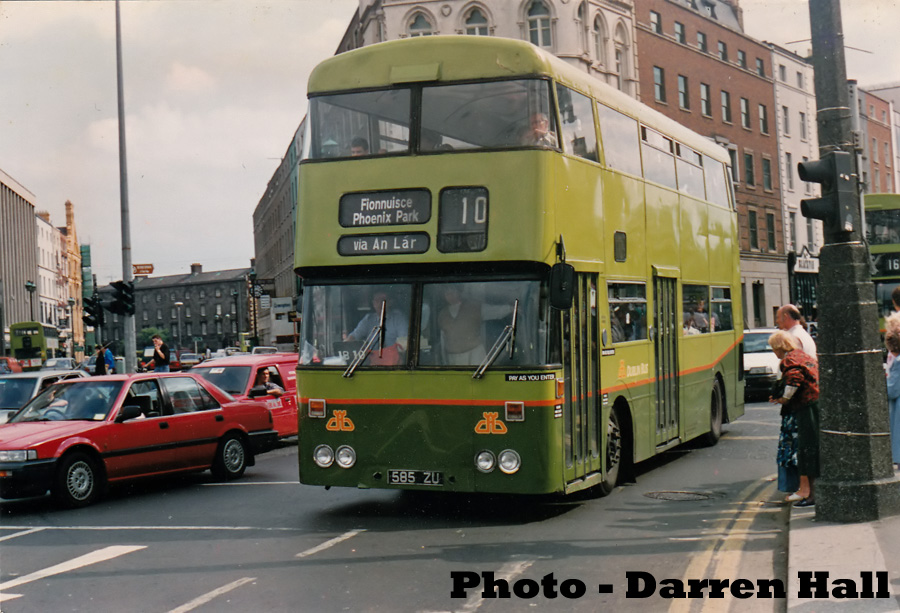
DAF re-engined CIE Metal Sections bodied Leyland Atlantean PDR1A/1, DF585, is seen operating a Route 10 service to the Phoenix Park on O'Connell Bridge on the 14th August 1991. DF585 is devoid of advertisements, contrasting with the picture of DF566 before. Delivered to Ringsend in the Spring of 1974, this bus would transfer to Phibsborough DF585 lasted until October 1991, before being withdrawn with the delivery of RH117-120.
The General Secretary of the DUTC, R.S. Tresilian, went about detailing each of the lines after the electrification of the network had been completed. This was published in 1902 entitled "A Guide to Dublin and Suburbs". It is quite interesting, each line been described by a constant stream of consciousness, all without full stops. Reprinted in 1907 to correspond with the World's Fair in Dublin from which I quote:
"Donnybrook to Phoenix Park: Distance 2.75miles, cars run every 4 minutes:
The route on this line differs from the preceding (routes being referred to here are Dalkey, Howth, Terenure and Palmerston) in that cars do not start from the centre of the city, but from a populous suburb on the south side and pass through the centre of the city and by Nelson's Pillar to another suburb on the north side.
The southern terminus if situated almost on the site of the old Donnybrook Fair, so celebrated for its fun and ructions in old times, and thence the Cars start and pass through the village of Donnybrook, along Morehampton Road, Waterloo Road and Upper Baggot Street, where, at Baggot Street Bridge, they enter the city, pass through Lower Baggot Street, down Lower Fitzwilliam Street and along the east side of Merrion Square, then the north side of Merrion Square, then along Clare Street, Leinster Street with the Leinster Club on the left, through Nassau Street with Kildare Street Club and Kildare Street on the lest, in which is situated the National Library and the Science and Art Museum; through the lower part of the fashionable Grafton Street (the Bond Street of Dublin), they come to College Green, with the statue of Grattan, the Bank Of Ireland, Dame Street, on the left, and Trinity College on the right; with statues of Burke and Goldsmith in front, they pass through Westmoreland Street, they then cross O'Connell, formerly Carlisle Bridge and passing through Lower Sackville Street, in which are the statues erected in memory of Sir John Gray, the originator of the Vartry water supply to Dublin, and of Daniel O'Connell, "The Liberator", this latter being the work of the great Irish Sculpture, Foley; passing Nelson's Pillar they proceed along Upper Sackville Street, with the offices of the company, and further up the Gresham and Hammam Hotels on the right, and at the end of this street the Rotunda Hospital and the Assembly Rooms on the lest, and along Rutland Square, Frederick Street, Blessington Street, with the Mater Misericordia Hospital on the right; they turn to the left on the North Circular Road, along which they continue, the Cattle Market on left, and the Marlborough Barracks on right, to the Phoenix Park gate, where they stop quite close to the Royal Zoological Gardens. Every second car, instead of turning down Fitzwilliam Street, continues through Lower Baggot Street, Merrion Row, and St. Stephen's Green, passing on the right the Shelbourne Hotel, then turns into Dawson Street, and at the lower end of that street again joins the route previously described."
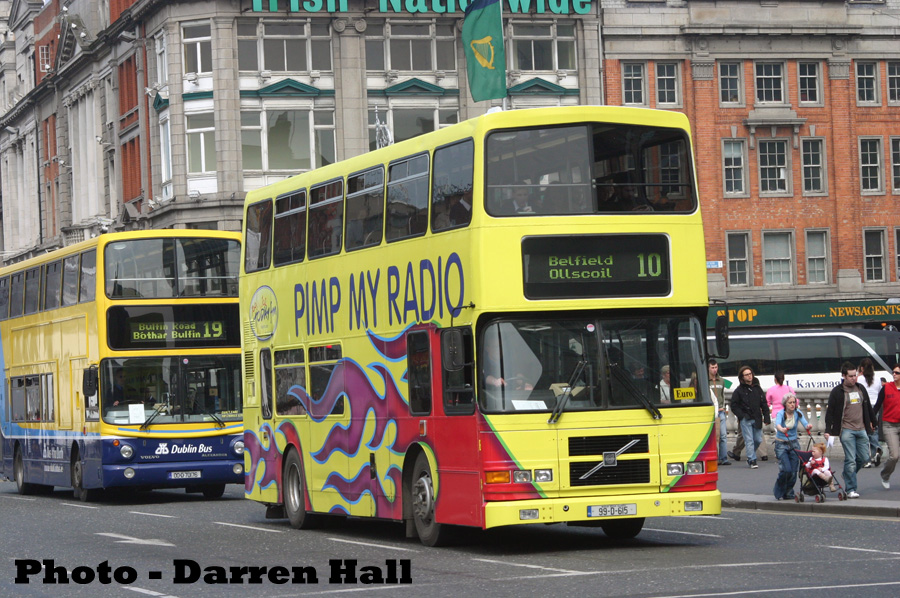
Alexander R-bodied Volvo Olympain, RV615, is seen operating a Route 10 service to Belfield on the 25th April 2005. This bus is shown in the attractive "Pimp my Radio" livery also worn by WV10 and RV328. RV615 was delivered to Conyngham Road in CitySwift Livery for use primarily on Route 25A. They carried Lucan Road 25A Flyer branding. As part of the vehicle movements coinciding with the opening of Harristown Depot on the 31st October 2004, RV615 moved to Phibsborough. It received this AOA in the Spring of 2005. RV615 moved to Clontarf for a few weeks in the Summer of 2009 due to the number of buses receiving maintenance there. It was then withdrawn to storage, but was placed back into service in August 2009 for the rail replacement 33X services required due to the collapse of the Broadmeadow viaduct on the northern commuter line. Clontarf operated this bus, mainly on Routes 27 and 29A, for a number of months as the AVL system was been rolled out on their buses. It was finally withdrawn from Clontarf in July 2010.
In the horse tram era trams were distinguishable from each other by the lettering applied to the trams. For example Donnybrook trams on their lower panels would have in very large font "Donnybrook" written upon them. Higher up it would say "via College Green and Merrion Square". This process would continue up to the dawn of electric traction with destination scrolls fitted in the mean time. However, with illiteracy common place in Victorian Dublin the DUTC went about indicating the different tram routes with a series of symbols. These symbols were placed above the destination box.
The symbol for the Donnybrook to Phoenix Park line via Merrion Square was two blue overlapping diamonds. Services via St. Stephen's Green and Lower Baggot Street via St. Stephen's Green used the same symbol but with a horizontal white bar. Literacy rates would improve and by 1918 the DUTC felt that the use of symbols was no longer needed. Trams would henceforth display route numbers, and a destination box to indicate their destination.
Services were numbered in a clockwise fashion starting from Sandymount in the south east. The Donnybrook services were given routes 9 and 10, the 9 being used for trams via Merrion Square and 10 being used for trams via St. Stephen's Green.
In 1918, with World War I ongoing, Ireland found itself suffering from the severe shortages of supplies throughout the British Isles. This was especially the case for coal, which was used to generate the electricity needed for the operation of the trams. The Director of Cross Channel Transportation issued many rules and regulations to be enforced in order to save coal. One of the regulations specifically dealt with the tramway operations: "The Tramway Companies should be required to revise their services so as to get the maximum saving in the consumption of coal".
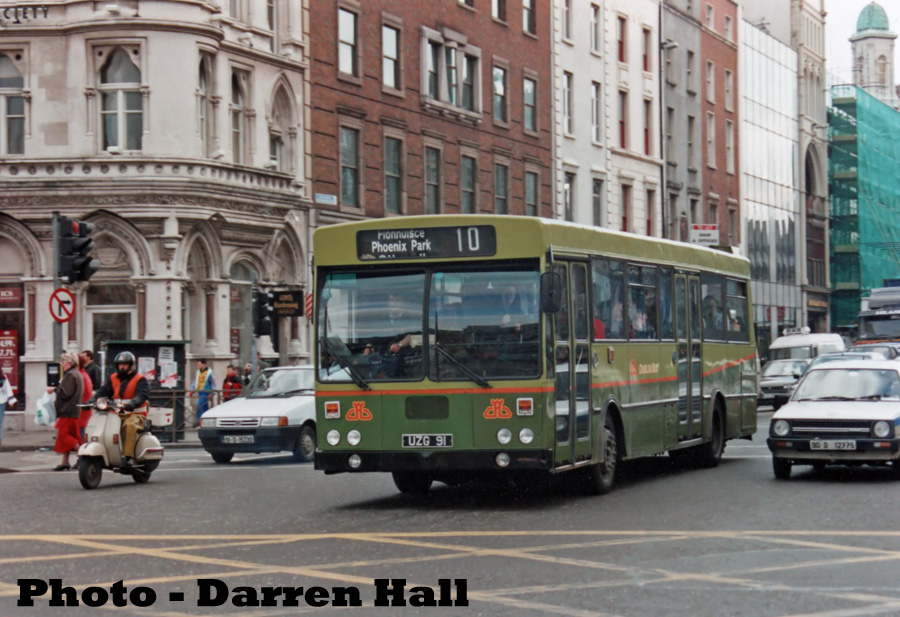
GAC single-decker, KC91, is seen operating Route 10 on Westmoreland Street on the 29th March 1994. KC91 was delivered to Capwell Depot in Cork in the Summer of 1984. It was transferred to Phibsborough Depot in the Summer of 1989. In May 1992 it received a prototype CitySwift livery, though it did not operate in service like this. The livery was similar to the CitySwift livery chosen, as applied to AD18 above, however it was more triangular and the front was more blue (see Pat Losty's excellent KC feature for a picture of this bus in this livery). Only the offside was done, the nearside was a base white. The need for the new livery was the order of 40 DAF SB220s, the P-Class. In mid-July 1994, KC91 was taken out of service as the last of the P-class were placed into service. It was transferred to Clontarf Depot for the replacement of the last AN68s there. It was withdrawn from service at Clontarf following delivery of RV400-407.
The tramway company had a severe shortage of coal, which they estimated was only enough to keep the current service going for 28 days. In order to comply with the order of the Director of Cross Channel Transportation a number of services were discontinued.
At that moment in time the Unions and the DUTC were embroiled in an argument of wages. The curtailment of services was viewed by the Unions as an action against the workforce. To some extent they had a point. The Clonskea depot seems to have been hit heavily, with 26 union staff dispensed with. Four non-union staff in the depot, on the other hand, were transferred to another depot.
The Route 10 tram from Phoenix Park to Donnybrook, via St. Stephen's Green, was curtailed from the 21st March 1918. This was the first time that the 10 was cancelled. In the notice of curtailment it was specifically noted in the press that the trams previously used on Route 10 would instead be used on a service from Clonskea to the Phoenix Park. This makes sense given the reduction in workforce at Clonskea depot. This was numbered Route 11 (see Route 11 article) and increased the frequency of the Phoenix Park section of the line, serving alongside Route 9. With the 10s cancellation, Lower Baggot Street was again without a tram service.
The 10 however made a reappearance on Monday the 16th June 1919. It was again a service run in conjunction with another as it had been with Route 9, with trams alternately being 10s in the timetable. This time it was Route 11 that it ran alternately with, Route 11 trams running from Clonskea to Drumcondra Bridge, while Route 10 trams ran from Clonskea to Finglas Road. The exact routing was as follows:
Clonskea (Vergemount), Sandford Road, Ranelagh Road, Chelmsford Road, The Appian Way, Leeson Street, St. Stephen's Green East, St. Stephen's Green North, Dawson Street, Nassau Street, Grafton Street, College Green, Westmoreland Street, O'Connell Street, Parnell Square East, North Frederick Street, Blessington Street, Berkeley Street, Berkeley Road, North Circular Road, Phibsborough Road, Prospect Road (terminating at corner of Finglas Road).
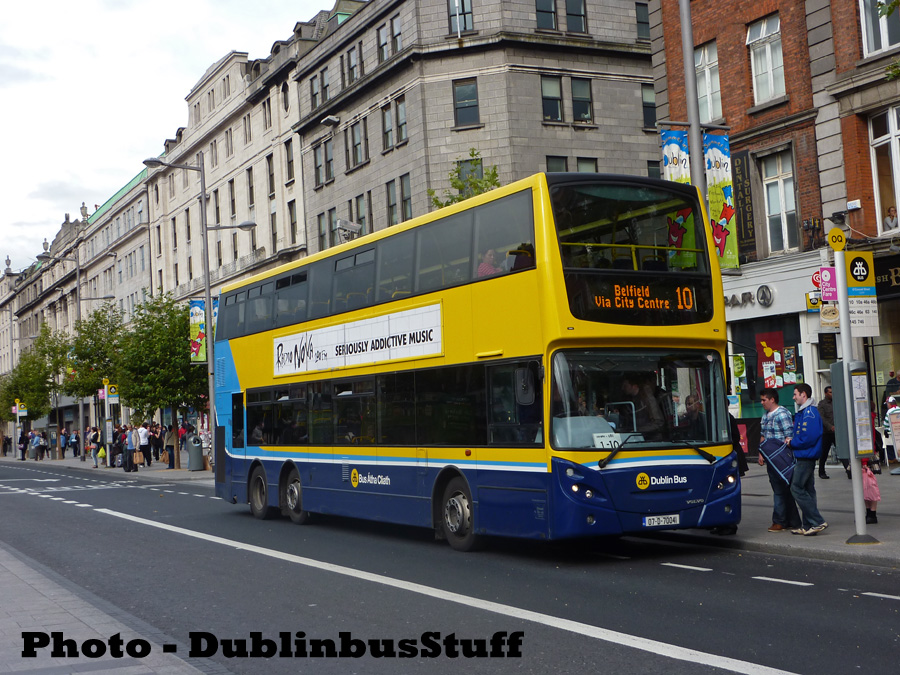
Alexander Dennis Enviro500 bodied Volvo B9TL, VT41, is seen operating a Route 10 service to Belfield on O'Connell Street on the 7th September 2010. VT41 entered service in Phibsborough Depot in January 2008. The VT class, with their extra capacity, are used on the busier of Phibsborough's services, Route 10 being one, though only occasional departures are covered. VT41 is seen here on Bus 1 of the 10.
This date is often misquoted as the 6th June 1919, however reference can be made to the Irish Independent of the 14th June 1919 (Pg: 2) for the notice re the route's operation. The 11s northside service to the Phoenix Park was replaced as of Monday the 16th June 1919 with a new Route 5.
This new service followed Route 10's former route from Phoenix Park to Baggot Street before continuing along Pembroke Road and Merrion Road, terminating at the corner of Sandymount Avenue which the DUTC termed as "Pembroke". Thus the Lower Baggot Street area again had a service, and a new connection was made between the city centre and Pembroke Road. The exact routing was as follows:
Phoenix Park Gate, North Circular Road, Berkeley Road, Berkeley Street, Blessington Street, North Frederick Street, Parnell (Rutland) Square East, O'Connell (Sackville) Street, Westmoreland Street, College Green, Grafton Street, Nassau Street, Dawson Street, St. Stephen's Green North, Merrion Row, Baggot Street Lower, Baggot Street Upper, Pembroke Road, Merrion Road (terminating at the corner of Sandymount Avenue).
Route 5 did not have a Sunday service, and operated with only half the frequency of the number 9. In order to boost the Sunday service between Nelson's Pillar and the Phoenix Park a route 9P was operated between these points.
The 10 lasted in this form until 1922 when the 11 became the sole route from Clonskea to Drumcondra. The 14 service from Dartry was instead extended northside to terminate at the corner of the Finglas Road.
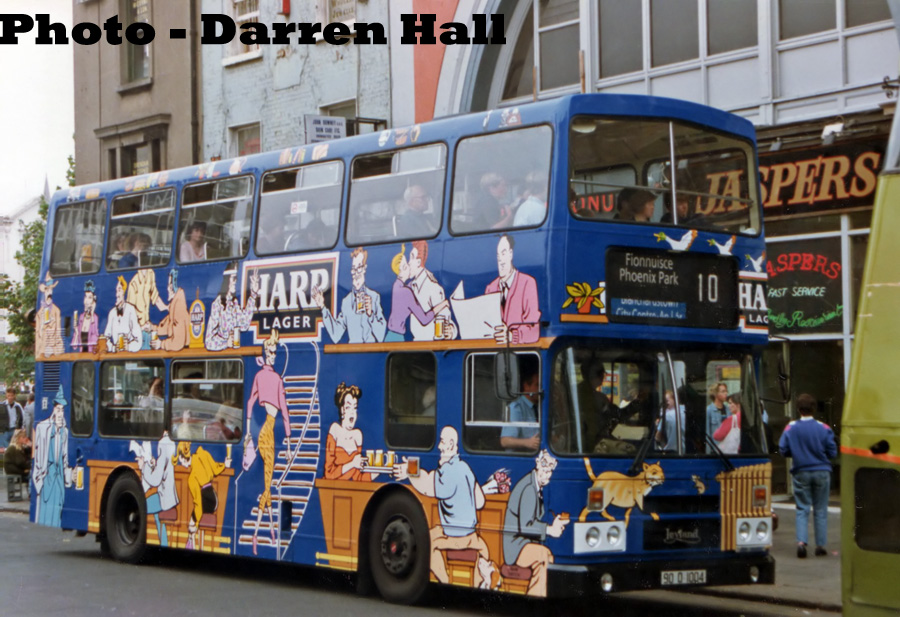
Alexander RH-bodied Leyland Olympian, RH4, is seen operating Route 10 on O'Connell Street on the 27th August 1991. It is seen here in a very attractive Harp Lager livery. Delivered to Phibsborough Depot in May 1990, it was part of the first batch of Olympians, the first new double-deckers acquired for the fleet in seven years, the first for the new Dublin Bus. RH4 carried many overall advertisements, no doubt due to its regularity on the high profile cross-city 10 route. RH4 was only just into its new livery when this photo was taken. The campaign was quite sizeable in that 6 buses were so treated, RH4 (Phibsborough), RH9 (Ringsend), RH24 (Summerhill), RH40 (Donnybrook), RH64 (Clontarf), RH65 (Conyngham Road). The advertisements were carried for about a year before being discontinued. RH4 was in two-tone green for less than a year when in the Spring of 1993 it received an AOA for the Irish Kidney Association. It transferred to Donnybrook in the Winter of 1994 for use on the 46A for greater southside exposure. Transferred back to Phibsborough it regained fleet livery. However it was only a few months back in Phibsborough before it was sent to Donnybrook again in exchange for its AOA bus RH40, which was now in Swatch livery. It spent about 2 months there before they were again swapped. In the Autumn of 1999, RH4 was converted to open top for use on the Sightseeing tours out of Summerhill Depot. In the Winter of 2002, Broadstone began operating the City Tours, and hence RH4 transferred there. It was withdrawn in the Spring of 2008.
The 10 tram returned in its original form on the 1st November 1928, operating from Phoenix Park to Donnybrook via St. Stephen's Green. It had ceased running this route for over 10 years. Again the service was alternated with Route 9. The 5 as and from this date was cancelled. As has been shown, even though the 10 may be the current service associated with the Phoenix Park it was in fact the 9 that was the principle service in tram days, the short Phoenix Park services being numbered 9P.
The 9 and 10 remained in this form until their replacement by buses in the early 1940s. This was as part of a system wide withdrawal of the tram, which would not finish until 1949 due to a shortage of new buses caused by the war. The bus had developed significantly from its earliest days and was more and more able to compete with the trams in terms of comfort and reliability. The main factor was however that it was cheaper to run, there was no need for a permanent way and all the other staff required in its upkeep. It was more flexible, provided faster journey times and bus routes could be extended or diverted at a whim, and at least initially they were less susceptible to traffic jams and illegally parked cars.
The date of tram withdrawal on Routes 9 and 10 was the 1st June 1940, double-deck buses taking up the service the following day. These routes were the last cross-city tram lines, having also been the first. The last car out of the Phoenix Park on that Saturday night was DUTC Tram 206, operating the last service to Donnybrook, it being a Route 10 departure via St. Stephen's Green. A great crowd turned out to wish the trams farewell, and a makeshift band played tunes for the crowd to sing along to as the last of the trams departed. The final tram was full of people, and it was waved along as it passed along its route. At Donnybrook the tram was met by further crowds, the tram continuing into the depot instead of its usual terminus point. The crowds alighted, some with souvenirs, a sorry precursor to the events of the last Dalkey Tram 9 years later, and the 10 tram finally came to an end. The crowds that had gathered outside the depot were said to have sung Auld Lang Syne, a fitting farewell for a reliable servant of the city.

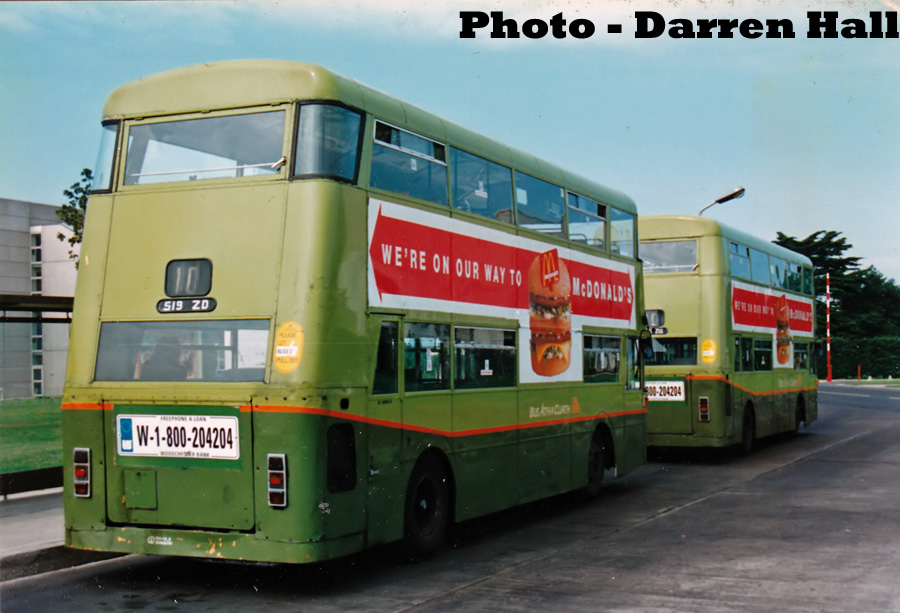
DAF re-engined CIE Metal Sections bodied Leyland Atlantean PDR1A/1, DF519, is seen at the Belfield Terminus in January 1992. It was delivered to Phibsborough in January 1973. It gave 22 years service before being withdrawn in June 1995. It was one of the last PDR1A/1s in the fleet, Phibsborough keeping D376, DF512/519/565 for three years after the rest of them had been withdrawn from service. They out saw most of the Van Hools that had come after them. Towards the end it was only used during school terms, being given the Summer off. In June 1995, after the school term finished, it was finally withdrawn. The second photo of DF519 is a rear shot, also taken at the Belfield terminus at a different point. DF519 looks quite battered, though it still retains its curved back windows something that is not the case for the unidentified Atlantean in front.
The two termini changed slightly upon the introduction of the bus service though otherwise the routings did not. The Phoenix Park terminus for the trams was on the North Circular Road, directly in front of the gates to the park. The buses however where extended to their current terminus on Infirmary Road. A turning manoeuvre was performed at the corner of Aberdeen Street and Infirmary Road.
On the other side of the city Trams had terminated on the main Donnybrook Road outside the depot. However, with the introduction of the buses, the terminus was changed to Anglesea Road at the wall of the church. Buses from the city turned left onto Anglesea Road and then performed a u-turn around the obelisk (Arthur Morrison monument). Buses pulled in at the wall of the church facing Donnybrook Garage, waiting their time, before turning right of Anglesea Road onto Donnybrook Road on their inbound journey.
The exact garage(s) used by the 9/10 buses initially is unknown. There is reason to believe that Donnybrook operated double-deck buses in DUTC days, probably operating these routes in conjunction with Conyngham Road, however it is also believed that Donnybrook did not have double-deckers towards the end of the war, or at all before the end of the war, suggesting the route may have operated from different garage(s). However, it is known that by the late 1940s, in CIE days, that the 9/10's allocation was split between Conyngham Road and Donnybrook, harking back to the tram days when they were shared by Donnybrook and Cabra depots.
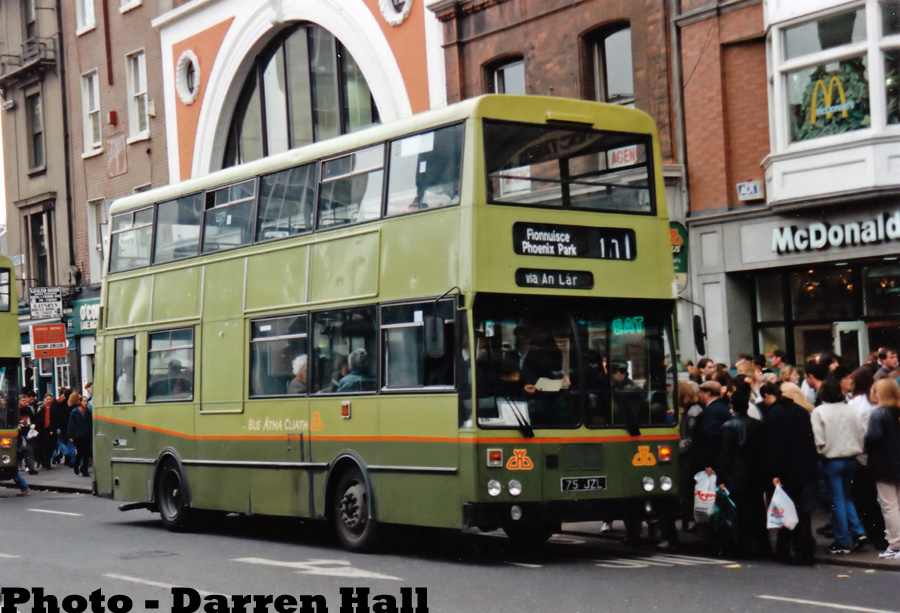
Bombardier double-decker KD75 is seen loading passengers at its O'Connell Street stop in the Christmas of 1995. KD75 was delivered to Summerhill in December 1981 as part of the batch KD71-91, working primarily on Routes 20/A, 54/A. It operating there for 14 years before transferred to Phibsborough, where it spent its last few months of operation before being withdrawn in the Summer of 1996. Its withdrawal was made possible due to the delivery of RA264-277 to Clontarf for the new 27 CitySwift service. This allowed Clontarf to release RH159-167 to be transferred to Phibsborough allowing Bombardiers to be withdrawn.
In 1951, the major roads in the city centre were resurfaced. This was to provide "non-skid" asphalt. The tramways had finally ceased to exist in 1949, and no doubt the tram tracks and other infrastructure associated with the running of rails was a hazard to free flowing traffic. Hence this resurfacing work was seen as a way of ridding the city of traffic. How wrong they were...
On Friday 20th April Route 10 buses were diverted due to road resurfacing on College Green. 9 and 10 buses heading Northbound from Dawson Street were diverted via Nassau Street, Lincoln Place, Westland Row, Pearse Street, D'olier Street to O'Connell Bridge. Route 9 buses joined Route 10 buses at Westland Row, using Merrion Street Lower from Merrion Square North. Thus the Donnybrook service was once again running via Westland Row, though it should be noted that buses running via Donnybrook such as the 46s etc.. had used Westland Row from their inception.
Nassau Street/Dawson Street were next to get resurfaced and from the 5th June buses on Route 10 used Grafton Street instead of Dawson Street heading southbound towards Stephen's Green. Northbound diversions remained in place. The resurfacing work in College Green, Nassau Street and Westmoreland Street was completed by the 5th July 1951. The 9 returned to its previous routing, however with work ongoing on Dawson Street the direction of Grafton Street was reversed to Northbound, which the 10 used between St. Stephen's Green and College Green. However the southbound route reverted to normal.
However, some of the diversions had freed up road space when in place. Though the overall fleet size back in the early 50s was less than it is now, the routes were much shorter. Hence the city centre streets had much more buses to contend with than is the case today. Therefore they were a major source of traffic problems. Westmoreland Street was a prime example of this. It was two way in the 50s and a large proportion of the city's bus services using this in at least one direction.
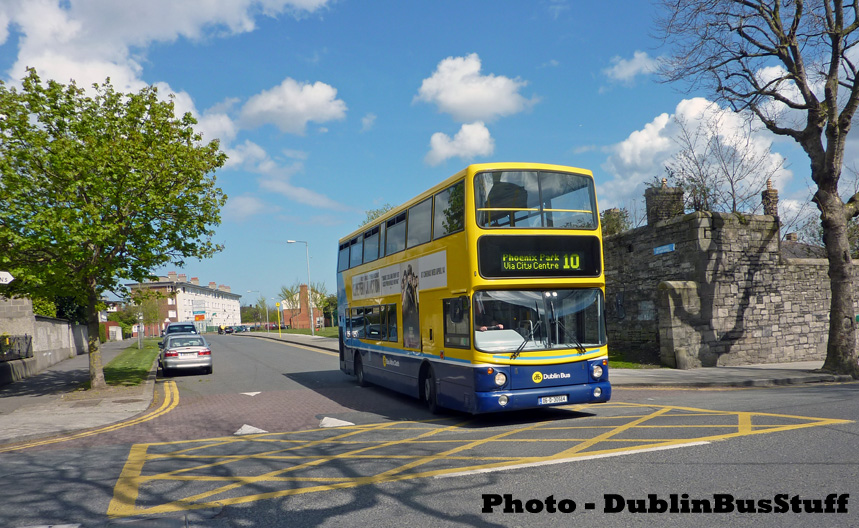
Phibsborough's AX564 is seen turning right out of Montpelier Gardens onto Infirmary Road on Route 10 on the 26th April 2010. O'Devaney Gardens can be seen to the rear. AX564 was part of a sizeable batch AX549-90 which were destined for fleet expansion but eventually found their way onto regular Phibsborough services. This bus if quite often allocated to the 10.
The first change to be made was to reroute some of the city's routes away from Westmoreland Street heading Southbound. The 9 and 10 were chosen as routes that would instead use D'olier Street and College Street to access College Green. This came into effect on the 12th July 1951.
On the 7th August new traffic regulations came into force in the city. The main points were the reversal of traffic flow on Grafton Street Upper to be northbound, with all traffic diverted left into Suffolk Street. Buses were banned also from using Grafton Street Lower, along the walls of Trinity College, however it remained two-way for car traffic.
From this date the 9 and 10 were diverted away from Grafton Street Lower onto Suffolk Street, Church Lane and College Green to access Westmoreland Street. The city routings of both routes need to be confirmed at this point:
Southbound (9): O'Connell Street, D'olier Street, College Street, Grafton Street, Nassau Street, Leinster Street South, Clare Street, Merrion Square North.
Southbound (10): O'Connell Street, D'olier Street, College Street, Grafton Street, Nassau Street, Dawson Street, St. Stephen's Green North.
Northbound (9): Merrion Square North, Clare Street, Leinster Street South, Nassau Street, Suffolk Street, Church Lane, College Green, Westmoreland Street, O'Connell Street.
Northbound (10): St. Stephen's Green North, Grafton Street, Suffolk Street, Church Lane, College Green, Westmoreland Street, O'Connell Street.
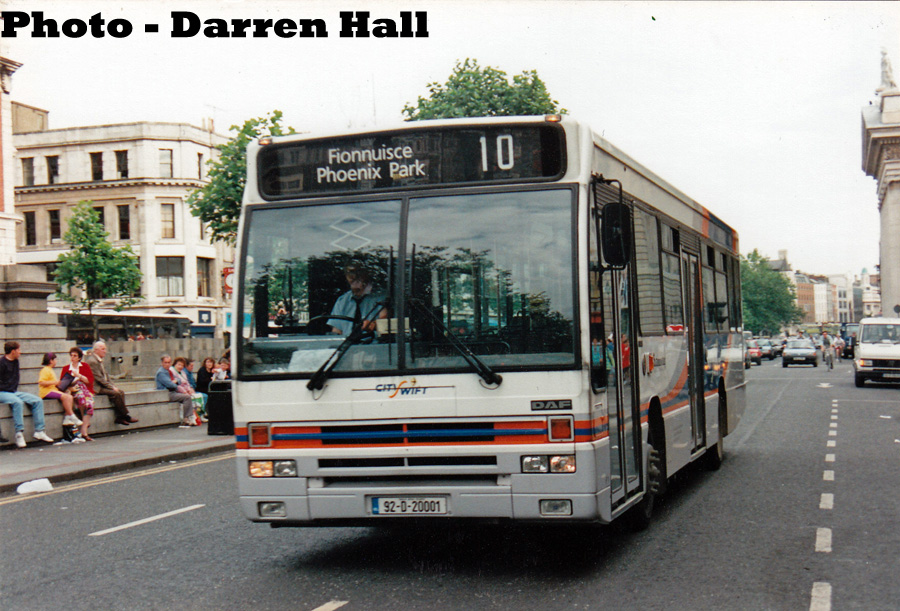
Plaxton Verde bodied DAF SB220, P1, is seen operating Route 10 on O'Connell Street on the 27th July 1994. As the prototype it arrived a number of months in advance of the rest, hence it received a "92 D" number plate, whereas the rest of the batch carried "93 D" plates. Its livery was a variant of the original prototype livery applied to KC91 in 1992. The P-class would have to wait until the Summer of 1993 to enter service, as prolonged Trade Union strikes delayed the introduction of the 39 CitySwift service. The prototype P1 (92 D 20001) was in a similar livery to KC91, with a combination of white, grey and blue stripes and the marketing branding, for route 39, is CitySwift. P1 would eventually lose its CitySwift livery in favour of CityImp in 2001. The success of the CityImp high frequency brand meant that higher capacity buses were required, the P class finding use on Phibsboroughs 134 and 122 routes. In the Summer of 2003 P1 was withdrawn from Dublin Bus service being transferred for further service in the Bus Eireann school bus fleet in Waterford.
The alternate running of 9 and 10 buses continued until late 1951, when the 9 was reduced in frequency and extended to Nutley Lane. By this stage the 10 was the dominant route of the two, the 9's diversion around Merrion Square not providing the same level of custom that Stephen's Green and Lower Baggot Street did. The extension of route 9 was as follows:
Donnybrook Road, Stillorgan Road, Nutley Lane (terminus corner Nutley Park).
By 1955 the 9 and 10 were joined at their Phoenix Park terminus by Route 14, further adding to the capacity of this trunk corridor. O'Devaney Gardens is a social housing scheme of high-ish rise flats built in the late 1950s. Upon construction the 9 and 10 were diverted via the complex on their way to their Phoenix Park, Infirmary Road terminus. The terminus arrangement was as it is now:
North Circular Road, O'Devaney Gardens, Montpellier Gardens, Infirmary Road (Terminus), North Circular Road.
Dublin's traffic conditions got progressively worse in the 1960s. One of the suggested solutions to the problem was to make vast areas of road space one way, while limiting the number of traffic manoeuvres that could be performed at important junctions. Though these solutions in the most part proved beneficial, they only stemmed the tide. They failed to act against the growing number of cars on the city's streets, only looking at ways to make them flow better. To this end only minor elements of this standpoint has changed up to the 21st Century, the College Green bus gate being an example of reducing city centre journeys, its limited hours however showing that the council still perceive the idea of people having to drive into the heart of the city.
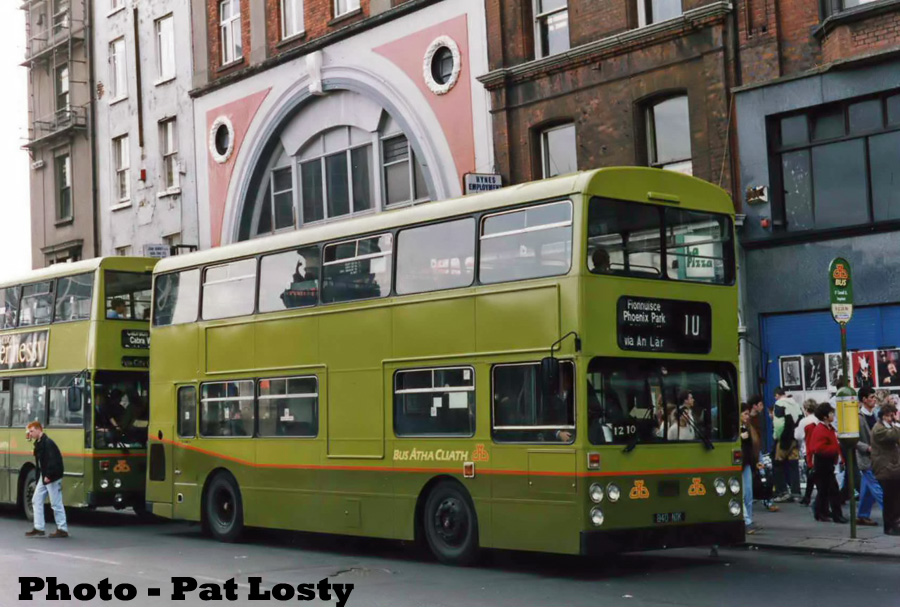
Van Hool/McArdle bodied Leyland Atlantean AN68, DF840, is seen in O'Connell Street on Route 10 in October 1991. D840 was the last Atlantean to be delivered to CIE, departing the workshops in January 1979. It was the last bus to be constructed in the Spa Works in Inchicore, the same place that the DUTC had built their first buses 54 years previously. It didn't enter service until September of that year as it was sent to FFG Hamburg who were recruited to design and build a new range of prototype buses. They deconstructed and reconstructed it again, detailing its makeup in order to aid their design of the KD class. It entered service in Conyngham Road. D840 was fitted with a fibreglass front on construction, as was all but one of the last batch of AN68s to Conyngham Road. This was similar to the front fitted to the PDR1A/1s. These were fitted in order to reduce wind resistance of the flat fronted buses. A fire at the Fibreglass workshop in 1980 meant that no new fronts could be constructed for the Atlanteans, and the PDR1A/1s and the fibreglass fronted Van Hools D825, 826, 828-840, were left with flat fronted sections as the fibreglass fronts became damaged. D840 would operate in Conyngham Road until the Spring of 1991, when it transferred to Phibsborough. It was one of few Conyngham Road Atlanteans that had not been fitted with DAF engines. The photo above is taken soon after the fitting of the DAF engine in Phibsborough garage, the unit been taken from withdrawn DF511. In the Autumn of 1994, DF840 caught fire and was withdrawn, ending any chance of this historic bus being preserved.
The first change to affect the 9 and 10 routes was the conversion of Nassau Street and Leinster Street to one-way eastwards on the 18th November 1964. The southbound routings did not change, however, the northbound routing of the 9 did. Instead of coming into the city via these streets the buses instead used a route via Westland Row. The exact northbound city routing was as follows:
Merrion Square North, Clare Street, Lincoln Place, Westland Row, Pearse Street, College Street, Westmoreland Street, O'Connell Street, Parnell Square East, North Frederick Street, Blessington Street.
Parnell Square was made one way on the 16th December 1964. This did not affect the 9 or 10's southbound routing but it did affect the northbound, which became:
O'Connell Street, Parnell Street, Parnell Square West, Parnell Square North, North Frederick Street, Blessington Street.
Stephen's Green was made one way on the 25th March 1965 with resulting changes to Route 10. The flow of traffic was clockwise, hence only the northbound routing was affected, becoming:
Baggot Street Lower, Merrion Row, St. Stephen's Green East, St. Stephen's Green South, St. Stephen's Green West, Grafton Street, Suffolk Street, Church Lane, College Green, Westmoreland Street, O'Connell Street, Parnell Square East, North Frederick Street, Blessington Street.
The one-way conversion of Nassau Street and Leinster Street South resulted in buses from Dun Laoghaire, Dalkey and Blackrock leaving passengers much further away from the shopping districts of Grafton Street and St. Stephen's Green. After multiple requests for a connection to be made from these districts and St. Stephen's Green, CIE decided to introduce a new route that would connect to them at Ballsbridge.
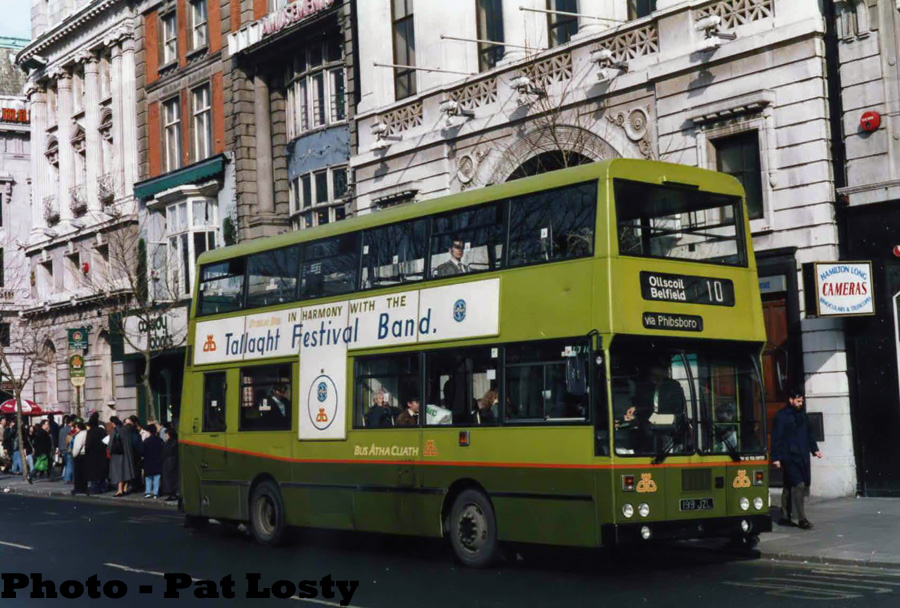
Bombardier Double-Decker KD199 is seen operating a Route 10 departure to Belfield on O'Connell Street in March 1992. KD199 was delivered in 1982 as part of a 25 bus batch to Phibsborough Garage, KD198-222. In the Summer of 1990 it was fitted with an experimental electronic dot matrix front display. This displayed the destination, but no via point was included. This photo is taken after the bus reverted back to its standard scroll setup. By the Summer of 1998, it was mostly on schools duties, being withdrawn for the summer. It lasted until early 1999 when further deliveries of RVs allowed it to be sent to the Driving School. It lasted there until the withdrawal of the KD class in late 2000, and was acquired for preservation.
This route was in the form of Route 4, Annamoe Road to Pembroke Road. At Pembroke Road passengers could connect with the Merrion Road routes. The route also provided more capacity on the 10 route, often being seen as a short 10, the services being interworked. This route started on the 28th June 1965. Its introduction seems to have been planned in advance as a timetable for the route appeared in the 14th June 1965 timetable.
Its termini were originally designated Hanlon's Corner (about a year later redesignated Annamoe Road) and Lansdowne Road, the exact routing being as follows:
Southbound: Annamoe Road, North Circular Road, Berkeley Road, Blessington Street, North Frederick Street, Parnell Square East, O'Connell Street, D'olier Street, College Street, College Green, Grafton Street, Nassau Street, Dawson Street, St. Stephen's Green North, Merrion Row, Baggot Street Lower, Baggot Street Upper, Pembroke Road (terminating on Pembroke Road using the wide junction at the corner of Pembroke Road, Lansdowne Road and Northumberland Road to turnabout).
Northbound: Pembroke Road, Baggot Street Upper, Baggot Street Lower, Merrion Row, St. Stephen's Green East, St. Stephen's Green South, St. Stephen's Green West, Grafton Street, Suffolk Street, Church Lane, College Green, Westmoreland Street, O'Connell Street, Parnell Square East, North Frederick Street, Blessington Street, Berkeley Road, North Circular Road, Cabra Road, Annamoe Terrace, Annamoe Road.
On Wednesday 25th May 1966, Merrion Row and Lower Baggot Street between Merrion Row and Pembroke Street were made one way. The 4 and 10's northbound city routings therefore changed in account of this, the exact routing between Baggot Street and St. Stephen's Green South being as follows:
Baggot Street Lower, Pembroke Street Lower, Fitzwilliam Square West, Pembroke Street Upper, Leeson Street Lower, St. Stephen's Green South.
Between the 12th February 1968 and the 9th June 1968, the 4's southern terminus changed to Shelbourne Road. The terminus arrangements were as follows:
Pembroke Road, Northumerland Road, Shelbourne Road (Terminus – about half way between Northumberland Road and Lansdowne Road), Lansdowne Road, Pembroke Road.
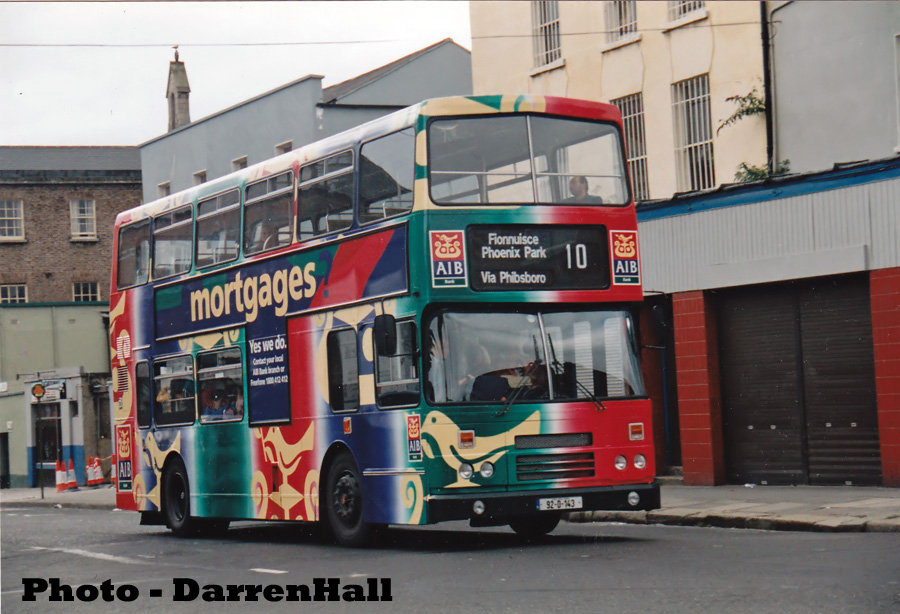
Alexander RH bodied Leyland Olympian, RH143, is seen operating Route 10 on Mountjoy Street in the Autumn of 1994. RH143 was delivered in April 1992, part of an 11 bus batch RH143-153 used initially on Route 46A. In the Autumn of 1994, this AIB AOA was applied, and soon after the bus was loaned to Phibsborough for use on Route 10, RH114 going the other way. It spent about 2 months there before the buses were switched again. By late 1997, it was back in two-tone green. In 2002, it became a spare bus in Donnybrook, being withdrawn during the school summer holidays. It was finally withdrawn in the Spring of 2006, but was reinstated to operate normal duties when the newer AX class were being used on the Ryder Cup Shuttles on the 19-24 September. Upon completion of these shuttles it was withdrawn completely from the fleet before being sold on for further use in the UK.
On the 29th October 1969 major road restructuring works on Berkeley Road, Blessington Street and Berkeley Street caused a new one way system to be initiated. Berkeley Road, Berkeley Street and Blessington Street were made one way into the city, while outbound traffic to Phibsborough had to use St. Mary's Place (also made one way at this point), Western Way, Constitution Hill and Phibsborough Road. Due to the major nature of these diversions it was also decided to make Granby Row one way northbound, and North Frederick Street one way southbound as per their current arrangement.
The 4, 9 and 10 north city route therefore became as follows
Northbound: O'Connell Street, Parnell Street, Parnell Square West, Granby Row, St. Mary's Place, Western Way, Constitution Hill, Phibsborough Road, North Circular Road.
Southbound: No change.
These road works were scheduled to last all of November and December, but no end date is currently to hand. After their completion Berkeley Street and Berkeley Road returned to two-way, and the road structure in this area was as it is today. It is not known whether the 9 was still operating at this point but the northbound north city routings became as follows, with again no change in the south city routings:
O'Connell Street, Parnell Street, Parnell Square West, Granby Row, St. Mary's Place, Berkeley Street, Berkeley Road, North Circular Road.
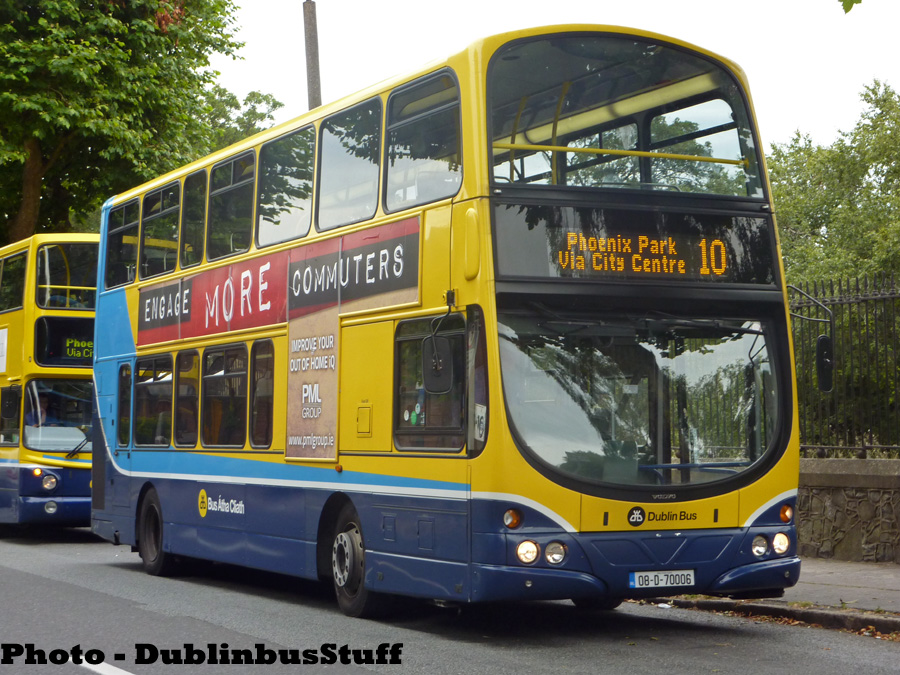
Wright Gemini bodied Volvo B9TL, VG6, is seen at the Phoenix Park terminus of Route 10 on the 16th August 2010. Entering into service in December 2008, VG6 can be seen on any of Phibsborough routes, the VG class being in demand seemingly from both passengers and drivers.
University College Dublin (UCD) was quite like how the Dublin Institute of Technology (DIT) is currently, in that it was spread around many buildings in the city centre of Dublin. The headquarters of UCD was on Earlsfort Terrace (National Concert Hall) , while other locations used were Cecilia Street, College of Science Merrion Street (now home to the Department of the Taoiseach), and Newman House on St Stephen's Green. It wasn't until the 60s that work began on providing an all encompassing campus for UCD on the Belfield site. It was even later that the growing body of students would be provided with a bus service onto the campus itself.
On Monday 27th January 1970 Route 10 was extended to the Belfield campus. The service ran Monday-Saturday to Belfield, while Sunday services remained at the Donnybrook terminus. At this time the Belfield flyover was not completed, thus at the time of the extension CIE announced that the official routing was via Foster's Avenue into Belfield. The quoted routing beyond Donnybrook was as follows:
Donnybrook Road, Stillorgan Road, Foster's Avenue, Owenstown Park to T-junction then left and follow road around to 11B terminus. From the 11B terminus head back the same way but continue through the junction from whence it had come to Ardmore Gates (where the flyover is today), Stillorgan Road, Donnybrook Road.
However the 10 either did not serve this routing or did for a very short space of time, as the routing in the early 70s was in and out via Greenfield Park. The current terminus was also not in place and it shared a terminus with the 11B, which also started that day.
From this date Route 9 ceased. On Sundays all Route 10 services operated to Nutley Lane, though this was soon changed back to Donnybrook Church, as were all Monday-Saturday night services. In the days of high church attendance, parking at the Donnybrook stop proved untenable. Therefore in the summer of 1971 early morning Sunday services (all departures prior to 1220) were extended to Nutley Lane. By this point the 10 was no longer operating via Foster's Avenue into Belfield. The service was instead using Greenfield Park, in both directions.

CIE Metal Sections bodied Leyland Atlantean PDR1A/1, D376, is seen operating a Route 10 service to Belfield in May 1991. D376 was delivered to Ringsend in the Autumn of 1970. It operated there for 12 years before transferring to Phibsborough along with D377 and D378. With the formation of Dublin Bus, it was one of the oldest vehicles. By early 1988, Donnybrook had withdrawn D290 which made D376 the oldest bus in the service fleet. In fact it was to retain that title for over six years. By September 1988 it was the only PDR1A/1 in Phibsborough not in green. However upon the 10s conversion to an OPO route, D376 was converted to an OPO bus and painted into the two-tone Green Dublin Bus livery. By the Summer of 1992 it was one of only four PDR1A/1s in service in Phibsborough. In the Spring of 1994, D376 was finally withdrawn from passenger services being passed on for tours work. It was painted in the Blue and Cream livery used in the 1960s, the lower saloon upgraded to carry more passengers with the removal of the middle doors. It was finally withdrawn from the fleet in the Summer of 2000 and was passed on to the Transport Museum of Ireland for preservation.
CIE's Dublin bus fleet had grown from 480 buses in 1946 to 890 buses in 1971. This had been due to a surge in suburban development. However the garages had reached saturation point with the number of buses, and CIE decided to place another bus depot on the Broadstone site. For much of the 60s, the Finglas routes, which were operated out of Summerhill buses, had their buses based in Broadstone. This was due to the chronic shortage of space in Summerhill.
On the 20th June 1971, Phibsboro Garage began operation. Routes 4 and 10 were part of the first group of routes that operated from this depot from this date, thus ending their joint operation between Donnybrook and Conyngham Road.
By 1973/74 the new flyover was built at Belfield Ardmore Gates, and from this point Route 10 used this road to and from the campus. It was at about this time that the 10 began to terminate at its current terminus, vacating that of the 11B.
Route 4 ceased in late 1983/early 1984 as part of a number of cutbacks in city routes. CIE was in financial difficulties, as was the whole country, and it was a necessity to prioritise their resources onto more profitable services.
CIE was rearranged into a holding company and three subsidiary companies on the 1st February 1987. The rail services became Irish Rail, while provincial bus services became Bus Eireann; Dublin City Services (DCS) becoming Dublin Bus. Dublin Bus went about a period of route rationalisation, duplication of cross city services being one of the principle cuts. Thus on Saturday the 30th January 1988, Routes 14/14A were withdrawn from the Phoenix Park, operating from D'olier Street to Churchtown only. By this stage the 14 service to the Park was only a shadow of its former self, with the frequency being continually cut back at the expense of City-Churchtown shorts. This left Route 10 as the only bus service to the Phoenix Park for the first time in its history.
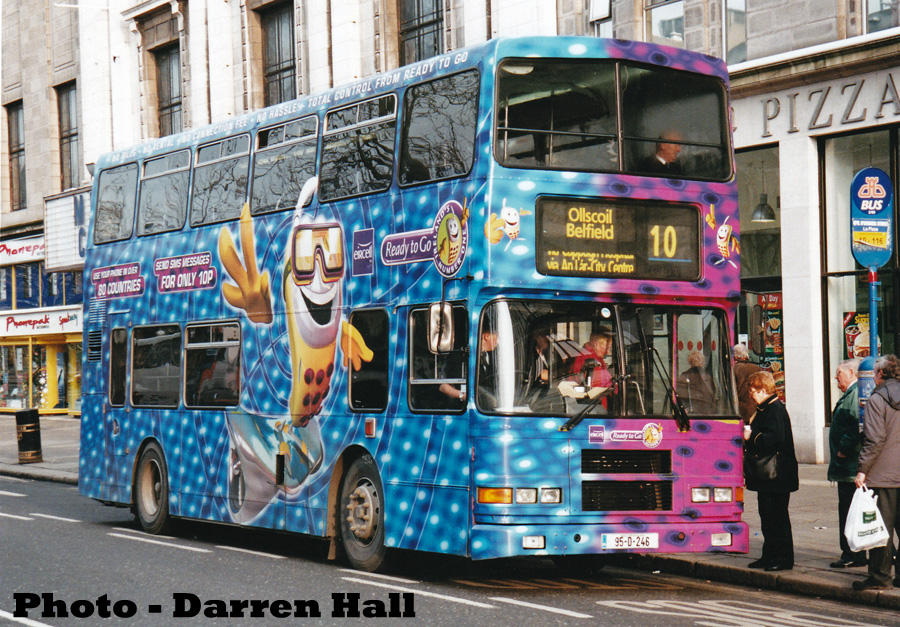
Alexander R-bodied Volvo Olympian, RA246, is seen on O'Connell Street on Route 10 on the 21st December 2000. It is in Eircell Ready to Go livery, which was a subsidiary of Eircom. It would eventually be sold onto Vodafone, another company that would make use of AOA buses. RA246 was delivered to Summerhill garage in the early Autumn of 1996 as RH246, part of the batch RH242-55. In late 1996, these buses were reclassified RA, to distinguish them from the Leyland Olympians, however they had the same Cummins engine. The next batch of Olympians would have a Volvo engine and were designated RV-class. The RA class designation had previously been used by CIE on their Leyland Titan PD3/2 fleet delivered in the late 50s/early 60s. With delivery of RV358-70 to Summerhill, RA246-51 were transferred to Phibsborough. After a few months there the Eircell advertisement was applied in late 1997. This advert would last till the Summer of 2001. By the Autumn of 2001, RA246 was withdrawn from regular service and converted to open top tours work.
Another one of the cost cutting policies was the continual introduction of One Person Operated (OPO) services. Though some single-deck services had been OPO from the mid-60s, CIE found it difficult to reach any kind of agreement on Double-Deck OPO. Finally in 1986 agreement was made. Though a number of services were made OPO in 1986, it was 1987 and 1988 that really saw the bulk of changes, the new company rapidly rolling out its introduction. On Sunday October 9th 1988 the 10 became one-person operated.
Nothing much happened over the next 14 years, the 10 being a constant in a much changing city network. The only thing of note came in 1994, when all shorts operating too and from Donnybrook/Nutley Lane (early morning/Night services Monday-Saturday and all day Sunday) were removed, all 10 services operating into the Belfield Campus.
A significant change occurred on the 28th July 2002. Up to this point the 10 was a double-deck service. In the 90s an occasional KC or P-class single decker would operate the route, but this was not the norm. However in July 2002, the 10 was allocated the 20 strong AW class. The AW class had been delivered in late 2000, but didn't enter service until March 2001. A number of peak time routes were created specifically for operation by the articulated bus AW class, namely the 39B, 65C, 90A, 127, and 129. These routes were operated out of Broadstone Depot, adjacent to Phibsborough Depot at the back of the old Railway terminal.
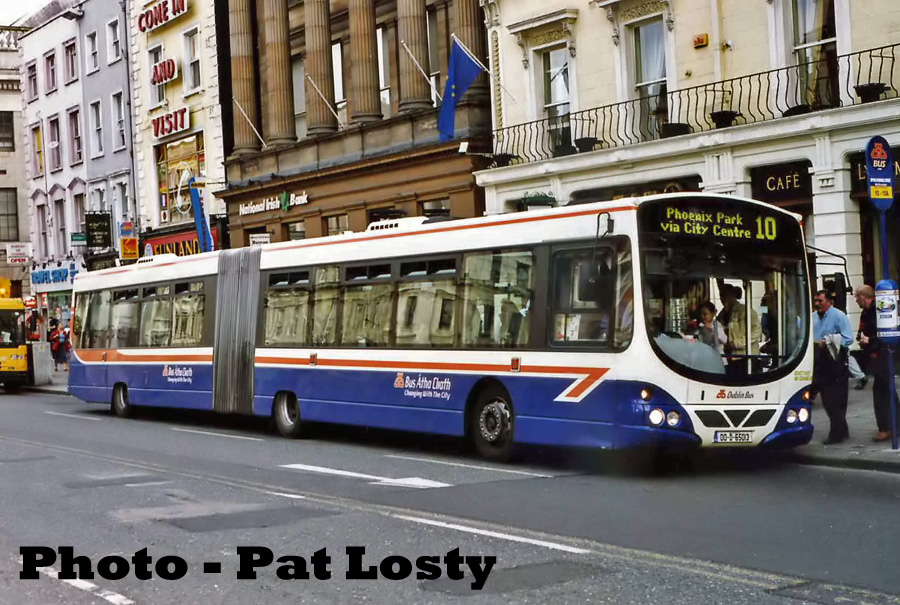
Wright Eclipse Fusion bodied Volvo B7LA, AW13, is seen operating Route 10 on O'Connell Street in August 2003. Delivered in late 2000, AW13 took the city streets on the 12th March 2001 operating peak hour Euro duties. The class then went to work on Route 10 on the 28th July 2002, lasting on this route till the opening of Harristown depot on 31st October 2004. Once again it was placed on Euro duties, before the inception of Route 4 (Ballymun - St. Vincent's Hospital) which bore almost no resemblance to the Route 4 (Annamoe Road to Shelbourne Road) 10 variant. Strangely enough AW13 should be withdrawn at the same time as Route 10, as surplus buses from Route 10 will transfer to Harristown to replace them.
However these expensive vehicles were underutilised on these services; operating basically only one peak inbound and outbound service. It was therefore decided to convert the 10 to AW class, with a basic 10min frequency (a slight reduction on what had operated before). With the arrival of the AW class in July 2002 came a new Route 10A, the first 10 suffixed route. It operated from the Phoenix Park to Sillorgan Village, following the 10 route almost in full but bypassing Belfield to operate to Sillorgan. These services operated in the morning peak, being about half the frequency of the 10 at this time, and were used as extra capacity on the very successful Stillorgan QBC. The routing from Donnybrook was as follows:
Donnybrook Road, Stillorgan Road, Belfield Slip Road, Stillorgan Road, Old Dublin Road, Stillorgan Village, Lower Kilmacud Road, Stillorgan Road, Belfield Slip Road, Stillorgan Road, Donnybrook Road.
As Broadstone had been equipped with longer pits to deal with these longer buses, the 10 was transferred from Phibsborough to Broadstone Depot. This situation lasted until the opening of Harristown, which was also designed to accommodate these articulated buses.
On the 4th July 2004, the flow of traffic around St. Stephen's Green was amended to accommodate the LUAS Green line services. As and from this date the southbound Route 10 routing changed around St. Stephen's Green, the routing being:
Leeson Street Lower, St. Stephens Green East, St. Stephen's Green North, Dawson Street.
On the 31st October 2004, Harristown Depot opened, the AWs being transferred there. At this point the 10/A reverted back to Phibsborough Garage and double-deck operation. And so it continued for another 6 years. But the death knell has finally tolled for one of the best known of all Dublin routes.
On the 30th October 2010, the 10 will operate its last service, a new 39A service from Ongar to Belfield replacing its southern leg from D'olier Street to Belfield. The northern part of the service will be covered by the extended Route 46A, which had joined the 10 for a short period at the Phoenix Park from the 19st September 2010. Dublin will say goodbye to a well loved, reliable service, a designation that cannot, as yet, be applied to its replacements. Hopefully someday these will too meet the standards set by the 10 route.
.jpg)
Alexander Enviro500 bodied Volvo B9TL, VT20, awaits its time for the first ever 46A departure from the Phoenix Park on the 19th September 2010. Alexander ALX400 bodied Volvo B7TL, AV309, sits behind on Route 10, awaiting its departure at the same 08:45 departure time as the 46A. The 10 was kept running until the Blanchardstown changes, and most specifically the 39A could begin operation. AV309 was delivered in 2003 and placed on Special Olympics duties. It would then operate from Ringsend Depot as part of the AV308-320 batch. In February 2009, AV308-18 transferred to Phibsborough.
Special thanks for this article must be given to eminent bus photographers Darren Hall and Patrick Losty for their excellent pictures that provide a historical reference to this historical text. Darren Hall, in collaboration with Johnathan McDonnell and Ian Molloy, has published two books celebrating the 20th anniversary of Dublin Bus and Bus Eireann in 2007. Both books are mandatory in any Irish Transport collection. Darren also runs a regularly updated Flickr site which is a bookmark for anyone interested in Irish Transport. Patrick Losty has, in collaboration with Dublinbus.cc, and formerly dublinbuses.com, created a series of online features covering year by year of Dublinbus' 23 year existence. Entited Wheeling in the Years it amasses a fantastic historical account of the companies existence through its vehicles. Pat has also compiled excellent features on the KD and KC classes and is currently (October 2010) running a feature on the RH Olympians in conjunction with DublinBus.cc. Pat also uploads his photos onto his own Flickr site.
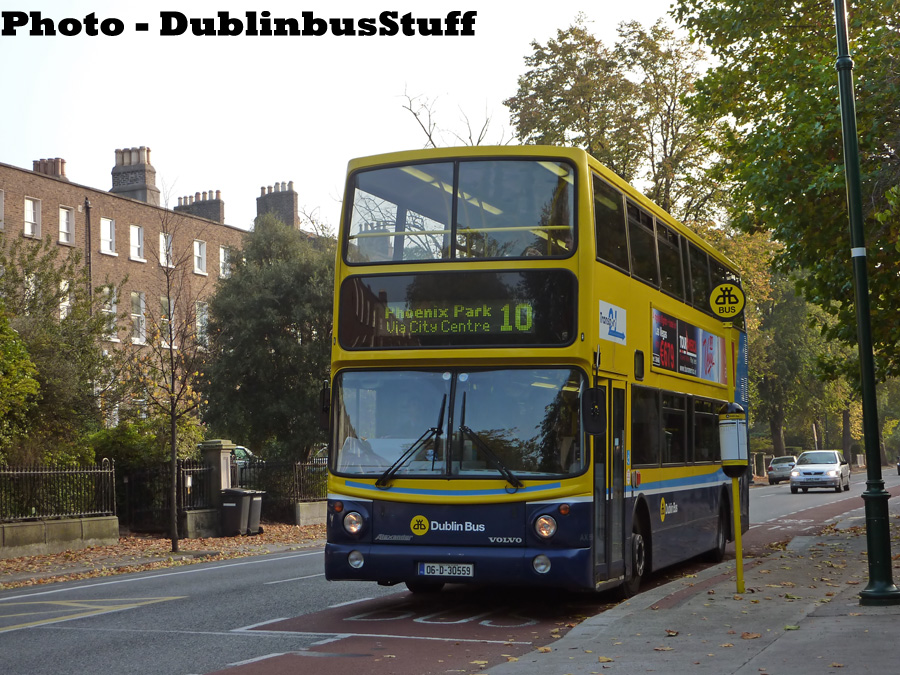
Alexander Dennis ALX400 bodied Volvo B7LDD, AX559, is seen operating Route 10 on Waterloo Road on the 10th October 2010, a 10 on 10/10/10. This bus is one of many that is allocated quite regularly to Route 10. The Autumn leaves fall on AX559, signalling a change in the seasons. They also signal the passing of the route. With the bowing out of the 10 next week it will be Route 39A, and most likely VTs, that will be photographed at this point. Farewell Route 10, you will be sadly missed.
